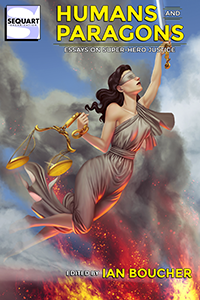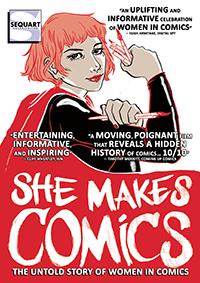I was continuing my journey through my imposing edition of The Complete Sherlock Holmes when I realized my mind could not stop making links between the original texts and BBC’s hit series Sherlock. While I may enjoy one and the other, the lack of female characters frustrates me in both mediums. This text will not be a critique that stops at the number of female characters or its Bechdel test result. No, the goal is to share my thoughts on the challenges and difficulties of adapting to our modern age a Victorian character with towering popularity such as Sherlock Holmes.
In the numerous tales of Sherlock Holmes, there are almost no recurring female characters, except Mrs. Hudson who is associated with domesticity. The women in Sherlock Holmes’s adventures are mostly victims and pawns to men. Women are not villains. If they commit any crime, it is always an act of defense vis-à-vis society or the individuals who abuse them. In other words, these female characters do not act, but react to male characters. Moreover, the crimes Sherlock investigates, when involving women, are mostly crimes of passion, possession, or jealousy. In these tales, sadly, women are almost always perceived as objects to be possessed, tamed, or secured. Even when loved, women are perceived as possessions:
“I tell you, there was never a man in his world loved a woman more than I loved her. I had a right to her. She was pledged to me years ago. Who was this Englishman that he should come between us? I tell you that I had the first right to her, and that I was only claiming my own.” – The Adventure of the Dancing Men
Even if Watson’s narration describes a woman’s motives and possible thoughts, they are his projections of her. Let me rephrase: because Watson is the narrator of every tale involving Sherlock Holmes, readers always perceive his adventures through his eyes, never from a neutral point of view. It is clear from the texts that Watson sees women through the values of Victorian society: a woman’s worth is shown by the purity of her conduct, intentions, and moral attitudes. English women ought to be fragile and virtuous.
Sherlock Holme’s adventures do not stand alone. They are a part of a vast tradition of objectifying women in detective story. For a long time, women in these stories were dangerous, unreliable, and unpredictable. I could go as far as Simone de Beauvoir’s theories to explain that the women described in these stories were persistently perceived by men as Other: a double or deceptive image. Men projected upon them their desires, but also their fears which made them dangerous. (Le deuxième sexe)
The first part of this text gives us an overview of how female characters must have been a problematic subject when Gatiss and Moffat first started to work on their adaptation of the famous detective and his stories. From my point of view, they did an impressive work. Generally, the critics toward Sherlock‘s female characters are centered on their small number and the way they are defined by their relationship to male characters. For example, if we look at the series from the beginning, very little episodes pass the Bechdel test. Still, we have to keep two things in mind when addressing these critics: in the original texts, only Mrs. Hudson is a recurring female character and both main characters are male. For this reason, staying true to the texts while incorporating good female characters is not an easy thing. When changing too many elements, an adaptation can end up standing on its own. A good example of that would be the CBS’s adaptation Elementary in which Watson is a woman, and Holmes resents his father and is obsessed by Irene Adler. Even if critics have called Elementary fresh, purists, like me, find its efforts of modernization lack the excitement of Sherlock Holmes’s original tales. To remain faithful to the texts while having more than one recurring female character, Gatiss and Moffat have introduced Molly, Sally, and Sarah, and modified characters present in the canonical texts like Irene Adler, Mary Watson, and Mrs. Husdon. Let’s take a closer look at some of them.
The Good
Mrs. Hudson
The BBC’s version of Mrs. Hudson gave her a past which truly puts a little color onto the character. We now know that the late Mr. Hudson was a criminal who got arrested for murder to Mrs. Hudson’s relief. Their relationship was purely physical, to take her words, which did not seemed to stop him from cheating. Just like in the texts, she cares for Sherlock and John, and takes care of the housework, because it’s her work, and also because she’s a caring woman.
Mary Watson
Mary is an important character in the story The Sign of Four. John and Mary get married after the adventure concludes and, while she is sometimes named in other stories, she never plays an active role after that first appearance. Her character in the series is much more improved. She has a troubling past and is referred to, like Sherlock, as a sociopath. She tries to leave her past behind her, but is unable to given Magnussen’s plot against Sherlock. She is not afraid to kill and to take action if it means her survival and the happiness with John she so desperately desires. A great improvement from the canonical character which was typically feminine in her passivity and non-existing role in her husband’s adventures.
Molly
Molly is a new character which adds a little female presence to the screen. She’s a successful, timid woman who has a crush on Sherlock. Nothing wrong there. Some people despise the fact that she is only seen as an accessory to Sherlock. I find it difficult to judge on that point, because it’s her principal function in the series. However, I admit the character is underdeveloped. Moreover, I fear for her lack of power if her only response toward Sherlock’s erratic behavior is slapping him over and over again. Let’s hope the series will develop this character’s potential, and that she’ll learn to reply to Sherlock with more wit than just a slap.
The Bad
Irene Adler
My general problem with Irene Adler is that, due to the lack of female characters and love stories involving Sherlock, every adaptation of Sherlock Holmes has Adler in it. She’s present in only one story, A Scandal in Bohemia, and yet she has become Sherlock’s woman. In the text, she outwitted him, escaping the country with a controversial photograph of the King of Bohemia in her possession and, for this feat, she is referred as the woman by Sherlock. His admiration transcends gender, emotion, and sexual desire.
“In his eyes she eclipses and predominates the whole of her sex. It was not that he felt any emotion akin to love for Irene Adler. All emotions, and that one particularly, were abhorrent to his cold, precise but admirably balanced mind.” — A Scandal in Bohemia
The BBC’s version of Adler is disappointing. She is not her own woman anymore. Not only does she admit receiving aid from Moriarty, but her maneuvers do not fool Sherlock, asserting him superior to her. I didn’t think it could be possible for the series to make it worse than the original texts, but Irene Adler passes from a clever active presence, equal to Sherlock’s, to a passive witness, or worse, a pawn, in the duel between the two superior men; Holmes and Moriarty. As if things were not already bad, she later becomes the damsel in distress saved by Holmes. (And I don’t even want to start on her crush on Sherlock that subdued her from her self-proclaimed homosexuality.) To me, Irene Adler is the series’s biggest failure. At least the original Adler manages to fool the brightest mind in England. What a disappointment that the series portrays her like a pawn to be used, the classic femme fatale with an overbearing sexuality, and the damsel in distress to be saved by the big, strong, and clever hero!
Sadly, one of the moments I really wanted to see in the series was erased from its original story. More precisely, the murder in The Adventure of Charles Augustus Milverton was not performed by Sherlock but by a woman. When asked on twitter on his choice of having Sherlock kill Magnussen himself (the series’s version of Milverton), Moffat answered: “In Doyle’s story, someone else shoots Milverton but we reckoned Watson was lying to protect his friend.” At first, I did not understand. I suppose I have read the text differently, because I have no problem believing John’s words that a woman killed Milverton. Then, I remembered that this modification from the canonical story actually shows consistency with Moffat’s vision of Sherlock Holmes. Although I enjoy the series, it is undeniable that Gatiss and Moffat put Sherlock as the center of everything. In Doyle’s tales, the story is as important as the famous detective. Watson’s narration tends to emphasize emotions, relationships, and circumstances as much as proving to his readers the vast superiority of his friend’s mind. The series is different from the books, because the BBC’s Sherlock needs to win. This simple fact could explain the ending of the third season where Sherlock kills Magnussen. In the original story, Sherlock and Watson witness Milverton’s murder from a hiding place behind the curtains of the room. Sherlock does not act, he does not win. They witness the conversation between Milverton and one of his victims, a lady, before she takes the matter into her own hands and puts an end to one of the worst men in London. She alone ends Milverton’s vast and shameful way of earning money and favors. I don’t want to believe it was too much for BBC’s Sherlock to have an empowered woman kill a villain. I prefer to see the decision of making Sherlock the killer as the continuation of Holmes being the center of attention, as Moffat seems to have a tendency to do for his heroes (Yes, I am referring to Doctor Who). The series’s universe does not give a lot of space to supporting characters, male or female, because the focus is always on Sherlock.
Ultimately, it must have been a challenge to adapt this very popular character into our age without straying too far from the canonical texts. Sherlock Holmes has been adapted into movies and series so many times before! It is my belief, as a reader of the original tales of Arthur Conan Doyle, that the BBC’s version of Sherlock Holmes is akin to the character I have read. Still, there is more work to be done on its female characters and, in fact, on its supporting characters in general. I can’t agree with people saying that Sherlock is sexist or anti-feminist. I believe it has besmirched Irene Adler and underplayed its female characters, but it is, as I said, not surprising coming from Steven Moffat who has a tendency to focus so much on the main character that the others suffer greatly and become stereotypes or shady versions of what they could be.




















































